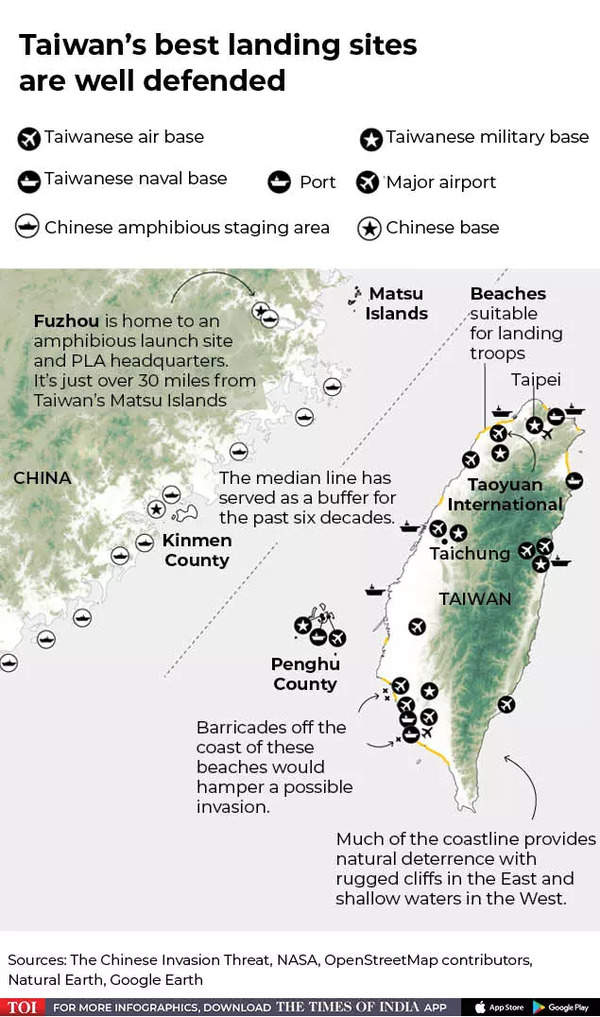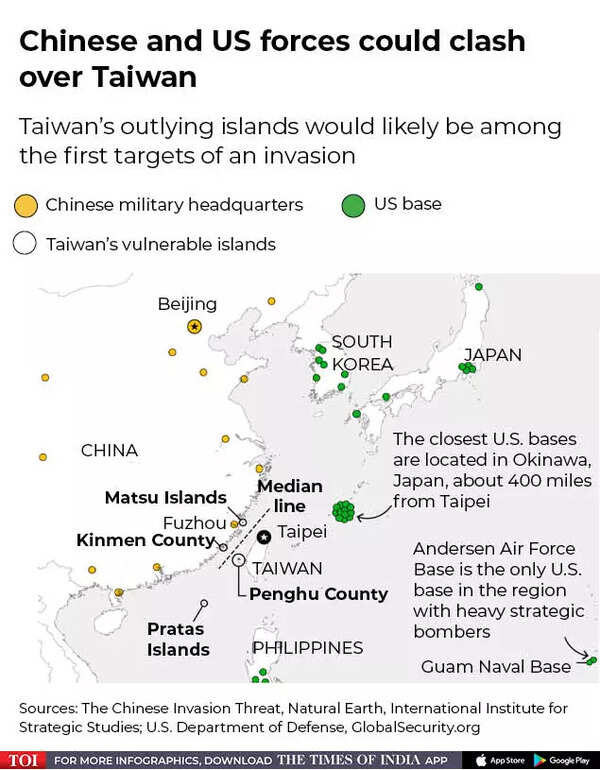
‘What if China attacks Taiwan?’: War game in US forecasts grim results
[ad_1]
Last week, China held a massive four-day exercise in Taiwan strait in a belligerent response to US House speaker Nancy Pelosi’s visit to Taiwan. During these drills, the People’s Liberation Army (PLA) performed realistic combat-scenario joint exercises in the sea and air space around Taiwan, practicing island capturing drills and bomber deterrence flights in Taiwan Strait.
The PLA said the drills were “a rehearsal for real operation”.

The military maneuvers of China have now prompted a group of American defence experts in Washington to focus on their own simulation of an eventual — but for now entirely hypothetical — US-China war over the island.
According to a Bloomberg report, an unofficial “what-if” game is being conducted in an office building near the White House. It predicts posits a US military response to a Chinese invasion in 2026.
While the experts are largely bringing the American perspective to the table, the hypothetical results show that a US-Taiwan victory, if there is one, could come at a huge cost.

Foreseeing grim results
The 7-hour war game, simulating three weeks of combat, illustrated what a daunting task it would be for China to launch an amphibious invasion across the 100-mile Taiwan Strait, Wall Street Journal reported.
According to the report, the exercise included “Red” (China) and “Blue” (US) teams.
The simulation also includes maps, 20-sided dice and complex computer calculations.
The imagined conflict is set in 2026, and each side is limited to military capabilities it has demonstrated in real life.
“The opposing teams take turns at maps of the Pacific region populated with game pieces denoting military dispositions, conferring on strategy. They then move to a detailed map of Taiwan. Computers calculate everything from the size of aircraft runways to how long it takes submarines to rearm. The dice introduce an element of randomness,” the report said.
The game basically assumes a scenario where China attacks Taiwan and US, which officially has a policy of “strategic ambiguity” on Taiwan, comes to Taipei’s aid.
There are no nuclear arms involved in the scenario.
The game plays out a scenario where the Chinese military shoots ballistic missiles at US air bases in Japan and an aircraft carrier strike group in the Pacific, destroying several squadrons of jet fighters and sinking the carrier and other US ships.
After bombing the island’s infrastructure and restricting Taiwan’s troop movement, China lands over 20,000 soldiers on the island’s southeast coast and moves northwards in hopes of seizing a port of airfield while avoiding cities.
” … As the days drag on, the momentum shifts to the US and Japan. Despite horrific losses in ships, aircraft and personnel, American forces bomb Chinese ports, eliminate the picket line of ships and successfully attack Beijing’s weak spot—the amphibious ships its needs to ferry troops and supplies to Taiwan,” the report said.
This is just one of the many scenarios that will run through September, with retired US generals and former Pentagon officials hunching like chess players over tabletops along with analysts from the CSIS think tank.
“In 18 of the 22 rounds of the game played to this point, Chinese missiles sink a large part of the US and Japanese surface fleet and destroy hundreds of aircraft on the ground,” a former White House defence budget analyst told Bloomberg. He added that allied air and naval counterattacks hammer the exposed Chinese amphibious and surface fleet, eventually sinking about 150 ships.
War games are played frequently by governments and outside organizations worldwide. But instructions to the participants in the CSIS project say that although the Pentagon “has conducted many such war games, they are all classified. As a result, information in the public domain is extremely limited. This project will fill that gap in public knowledge and thereby encourage discussion about US force structure and policies.”
[ad_2]
Source link


